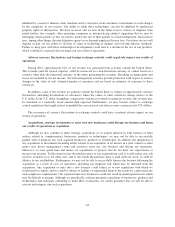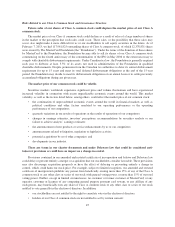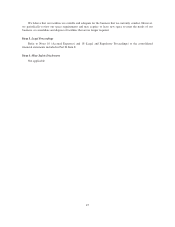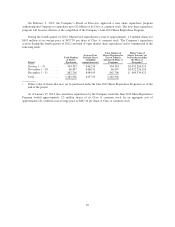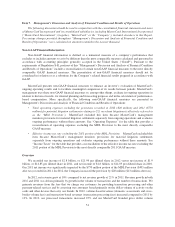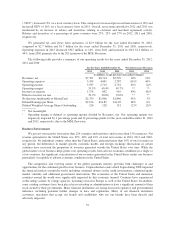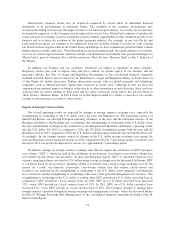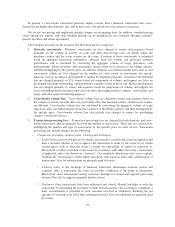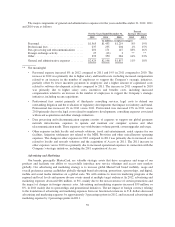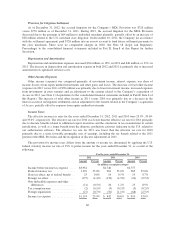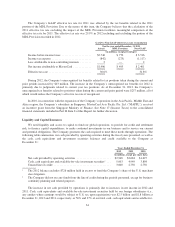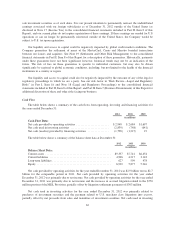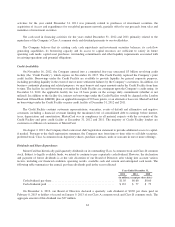MasterCard 2012 Annual Report Download - page 57
Download and view the complete annual report
Please find page 57 of the 2012 MasterCard annual report below. You can navigate through the pages in the report by either clicking on the pages listed below, or by using the keyword search tool below to find specific information within the annual report.MasterCard’s financial results may be negatively impacted by actions taken by individual financial
institutions or by governmental or regulatory bodies. The condition of the economic environments may
accelerate the timing of or increase the impact of risks to our financial performance. As a result, our revenue may
be negatively impacted, or the Company may be impacted in several ways. MasterCard continues to monitor the
extent and pace of economic recovery around the world to identify opportunities for the continued growth of our
business and to evaluate the evolution of the global payments industry. For example, in our Asia Pacific and
Latin American regions, we continue to see significant increases in dollar volume of activity on cards carrying
our brands in those regions while in the United States and Europe we have experienced growth in dollar volume
despite mixed economic indicators. Notwithstanding recent encouraging trends, the extent and pace of economic
recovery in various regions remains uncertain and the overall business environment may present challenges for
MasterCard to grow its business. For a full discussion see “Risk Factors—Business Risk” in Part I, Item 1A of
this Report.
In addition, our business and our customers’ businesses are subject to regulation in many countries.
Regulatory bodies may seek to impose rules and price controls on certain aspects of our business and the
payments industry. See Note 18 (Legal and Regulatory Proceedings) to the consolidated financial statements
included in Part II, Item 8 and our risk factor in “Risk Factors—Legal and Regulatory Risks” in Part I, Item 1A
of this Report for further discussion. Further, information security risks for global payments and technology
companies such as MasterCard have significantly increased in recent years. Although to date we have not
experienced any material impacts relating to cyber-attacks or other information security breaches, there can be no
assurance that we will be immune to these risks and not suffer such losses in the future. See our risk factor in
“Risk Factors—Business Risks” in Part I, Item 1A of this Report related to a failure or breach of our security
systems or infrastructure as a result of cyber-attacks.
Impact of Foreign Currency Rates
Our overall operating results are impacted by changes in foreign currency exchange rates, especially the
strengthening or weakening of the U.S. dollar versus the euro and Brazilian real. The functional currency of
MasterCard Europe, our principal European operating subsidiary, is the euro, and the functional currency of our
Brazilian subsidiary is the Brazilian real. Accordingly, the strengthening or weakening of the U.S. dollar versus
the euro and Brazilian real impacts the translation of our European and Brazilian subsidiaries’ operating results
into the U.S. dollar. For 2012 as compared to 2011, the US dollar strengthened against both the euro and the
Brazilian real. For 2011 compared to 2010, the U.S. dollar weakened against both the euro and the Brazilian real.
Accordingly, the net foreign currency impact of changes in the U.S. dollar average exchange rates against the
euro and Brazilian real decreased net income in 2012 compared to 2011 by 7 percentage points. Conversely, net
income in 2011 was positively impacted by currency by approximately 2 percentage points.
In addition, changes in foreign currency exchange rates directly impact the calculation of GDV and gross
euro volume (“GEV”), which are used in the calculation of our domestic assessments, cross-border volume fees
and volume related rebates and incentives. In most non-European regions, GDV is calculated based on local
currency spending volume converted to U.S. dollars using average exchange rates for the period. In Europe, GEV
is calculated based on local currency spending volume converted to euros using average exchange rates for the
period. As a result, our domestic assessments, cross-border volume fees and volume related rebates and
incentives are impacted by the strengthening or weakening of the U.S. dollar versus primarily non-European
local currencies and the strengthening or weakening of the euro versus primarily European local currencies. The
strengthening or weakening of the U.S. dollar is evident when GDV growth on a U.S. dollar converted basis is
compared to GDV growth on a local currency basis. In 2012, GDV on a U.S. dollar converted basis increased
12%, versus GDV growth on a local currency basis of 15%. In 2011, GDV on a U.S. dollar converted basis
increased 19%, versus GDV growth on a local currency basis of 16%. The Company attempts to manage these
foreign currency exposures through its foreign exchange risk management activities, which are discussed further
in Note 20 (Foreign Exchange Risk Management) to the consolidated financial statements included in Part II,
Item 8 of this Report.
53



